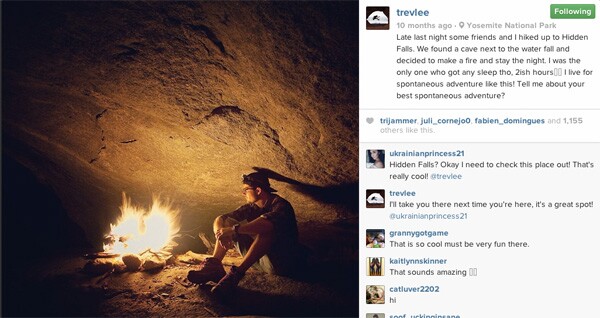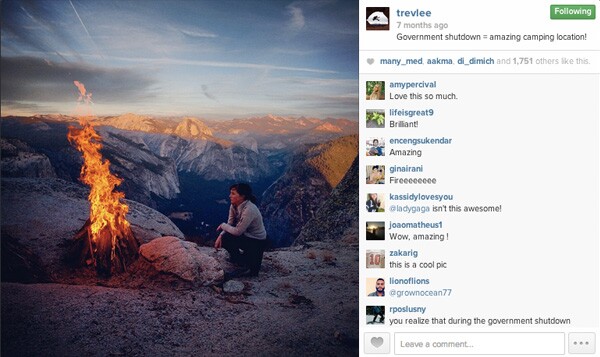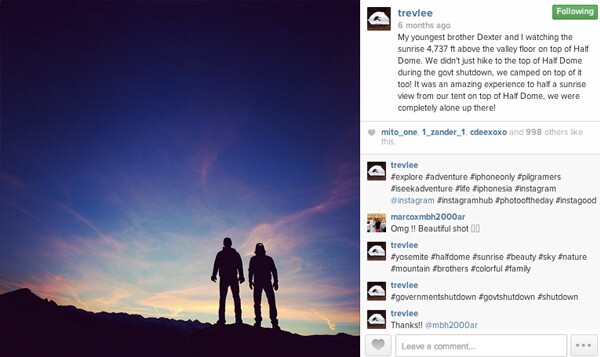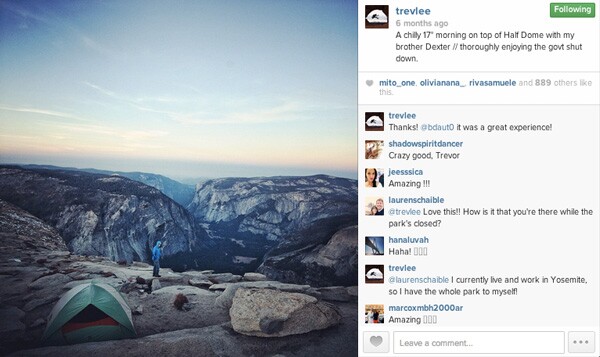Epic, Yet Illegal: Famous Yosemite Instagrammer Pleads Guilty in Federal Court

"Today has been a good day," he wrote in the caption of a wintry wonderland photo posted to Instagram. It was a crisp December afternoon in Yosemite National Park and Trevor Lee had gone on a hike through the snow and ice skated with the girl he was dating. Reason enough to be satisfied, but gaining some media fame must have helped. Lee, an employee at a park concessionaire of six months at that point, was just featured in Outside magazine and by Instagram's blogfor his adventures in the park.
The photos were epic. Camping with views over Yosemite Valley, climbing giant trees, aerial skateboarding, and so much more to inspire just about anyone to pick up and move to Yosemite immediately. Lee, known as @trevlee on Instagram, instantly began gaining thousands of more followers, which today totals over 50,000.
But there was one problem: many of the pictures depicted illegal activity, and four months later, Lee was in court facing nine misdemeanor counts.
At the time, it was Yosemite's second-ever case built on evidence collected from social media. In February, a Pennsylvania man pled guilty to vandalism on the Yosemite Falls Trail. "Bharani Ronanki was here" was spray painted in big black letters on granite rocks in two separate spots. Rangers Googled his name, easily leading to Ronanki's Facebook and Flickr pages. He ended up with a $5,000 fine, 160 hours of community service, and two years probation.
And the park may end up in another social media-based case later this year. A vandalism investigation is underway at 10 national parks, including Yosemite. Illegal paintings on natural surfaces allegedly by a woman named Casey Nocket, who goes by the name creepytings, were documented on Instagram and Tumblr and has become a national story.


But Lee's photos did not depict crimes so obvious, and it may actually be a more rampant problem than graffiti in national parks. A photo of a group of friends enjoying a campfire isn't always so innocent, after all. And for Lee, two campfire photos led to four charges filed against him, three which he pled guilty to earlier this month.
In one of the photos, a campfire was lit where fires were not allowed. In another, a fire was lit during the fire ban imposed due to the devastating Rim Fire, which was ignited by a hunter's illegal fire and ended up charring over 250,000 acres. The other charges generated by the two photos were camping in an off-limits area and camping without a permit, the latter charge eventually dropped by the National Park Service in a settlement.
One might shrug at charges like camping where you're not supposed to, but national parks are set up to protect unique natural resources. A night of camping in the wrong spot could damage sensitive habitat or ruin restoration efforts.



Three other charges brought against Lee also might have seemed innocuous at the time: skateboarding off famous rock climbing wall El Capitan, as well as climbing up and camping on Half Dome during the government shutdown ("thoroughly enjoying the govt shut down," he boasted in one photo caption). They were all dropped by the government during settlement talks, however. A park spokesperson explained that dropping charges was a normal part of plea agreements and could not elaborate on specific details.

But two more charges did stick. In November 2013, Lee posted photos of him and a friend climbing Giant Sequoias at Tuolumne Grove. While Lee has a penchant for climbing trees and extreme hammocking -- both generally allowed if damage is not done -- climbing a protected species is verboten. To boot, he did it during the Rim Fire closure.
In all, Lee pleaded guilty to five misdemeanor charges and was sentenced on October 7, garnering him a $1,500 fine and a year of unsupervised probation.
Lee and his legal team did not respond to multiple requests from KCET for comment, but in court documents, his court appointed federal defenders laid out a passionate case, concluding that Lee's conduct "represents an anomalous misjudgment that stains an otherwise stellar background," which includes community service with a youth ministry and the Special Olympics. They also credited him for admitting wrongdoing early into the investigation and for using his photography to encourage people to enjoy nature.
"Looking back on my time in Yosemite, I would have definitely done things differently," explained Lee in a court statement. "I would have made better decisions. I never had bad intentions; I love Yosemite and the beautiful community that lives there. I just wanted to capture Yosemite and share it with others who will never be able to. I never intentionally damaged nature or promoted any abuse of nature. I just wanted people to see how much I loved Yosemite in hopes I'd encourage them to see it for themselves."
The settlement also stipulates Lee to make a statement on his social media accounts recognizing the activities in many of his Yosemite photos were illegal. He'll also have to delete all such photos, even ones that were not the basis of charges.
Lee's defenders described some of his violations as "seemingly small," nonetheless Yosemite officials are taking a firm stance. "If we see people posting on social media sites, we will use that to build a case against people," park spokesperson Kari Cobb told KCET. Park officials don't want to see copycats. Lee, after all, has earned media attention, a boatload of followers, and a corporate sponsorship from REI, one of the biggest U.S. outdoor retailers, thanks in part to photos of illegal activity.
Yet despite the damaging effects it can have for people and places, social media can equally hold positive virtues. Yosemite's first big experience with social media came several years ago when word went viral that Horsetail Fall glows a magnificent orange each February. An annual phenomenon that once spread more slowly by word of mouth became an overnight sensation. People came out in droves, so much that officials now implement a traffic management plan.
And that, ultimately, is what Lee says he's trying to do with his photography. "Get off your couch, leave your comfort zone, and go find adventure," he wrote about one of his photos. "I don't ever want to become a spectator of life, I want to always experience first hand."
[November 12, 2014 update: Per the settlement agreement with the federal government, Trev Lee has posted a public apology to his Instagram account. "I post this statement as an apology and expression of my regret for what I did and in hopes it will discourage others from doing what I did," he wrote. "I make no excuses for my actions; they were not only irresponsible, but unlawful. I implore others not to make these same mistakes." Read the full statement here.]